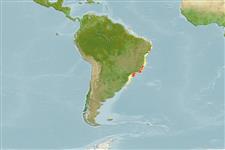>
Ovalentaria/misc (Various families in series Ovalentaria) >
Opistognathidae (Jawfishes)
Etymology: Opistognathus: Greek, opisthe = behind + Greek, gnathos = jaw (Ref. 45335); to the very elongate upper jaw of the type species of the genus, Opistognathus nigromarginatus (Ref. 128653); brasiliensis: Named after Brazil, along whose coast this species appears to be endemic (Ref. 26893).
Environment: milieu / climate zone / depth range / distribution range
Ecologie
marien demersaal; diepte 15 - 69 m (Ref. 129348). Subtropical
Southwest Atlantic: Brazil.
Grootte / Gewicht / Leeftijd
Maturity: Lm ? range ? - ? cm
Max length : 12.9 cm SL mannelijk / geslacht onbekend; (Ref. 26893)
Korte beschrijving
Determinatiesleutels | Morfologie | Morfometrie
Dorsale stekels (totaal) : 11; Dorsale zachte stralen (totaal) : 16; Anale stekels: 3; Anale zachte stralen: 15 - 16; Wervels: 28. Anterior nostril a short tube with simple cirrus on posterior rim; posterior end of maxilla of adult males produced as a thin flexible lamina that usually extends beyond posterior margin of opercle; spinous dorsal fin with black spot encircled by a very narrow white ring; dorsal fin with 5 or 6 dusky bands that extend onto dorsum; adult males with inner lining of maxilla and adjacent membranes with 2 dark stripes, one stripe in females; pectoral fin uniformly pigmented, no black speckles proximally; buccal pigmentation consisting of a dark area widely surrounding esophageal opening except for a pale area posteriorly that continues between upper pharyngeal tooth patches; caudal vertebrae 8 (Ref. 26893).
Founf on bottoms with gravel and sand or on silt and sand bottoms, near coral reefs and rocky areas (Ref. 129348). Mouthbrooders (Ref. 240).
Levenscyclus en paargedrag
Maturities | Voortplanting | Spawnings | Egg(s) | Fecundities | Larven
Employ mouthbrooding to care for their young (Ref. 240).
Smith-Vaniz, W.F., 1997. Five new species of jawfishes (Opistognathus: Opistognathidae) from the western Atlantic ocean. Bull. Mar. Sci. 60(3):1074-1128. (Ref. 26893)
Status op de Rode Lijst van het IUCN (Ref. 130435)
Gevaar voor de mens
Harmless
Gebruik door de mens
Tools
Speciale rapporten
Download XML
Internetbronnen
Estimates based on models
Preferred temperature (Ref.
123201): 20.2 - 23.1, mean 21.7 °C (based on 5 cells).
Fylogenetische diversiteitsindex (Ref.
82804): PD
50 = 0.5000 [Uniqueness, from 0.5 = low to 2.0 = high].
Bayesian length-weight: a=0.00389 (0.00180 - 0.00842), b=3.12 (2.94 - 3.30), in cm total length, based on all LWR estimates for this body shape (Ref.
93245).
Trofisch niveau (Ref.
69278): 3.5 ±0.6 se; based on size and trophs of closest relatives
Fishing Vulnerability (Ref.
59153): Low vulnerability (10 of 100).
